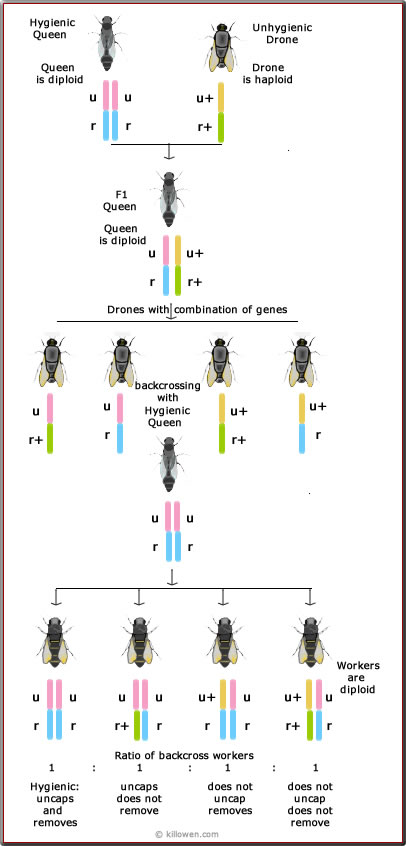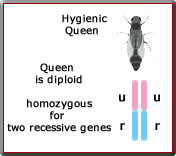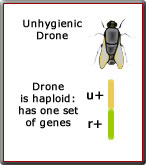Genetics 2D
Genetics and Hygienic Behaviour
In a paper published in 1964 entitled Behavior genetics of nest cleaning in honey bees. IV [12].The responses of F1 and backcross generations to disease-killed brood was investigated.
The study was primarily concerned with the investigation of the behaviour of worker bees from certain colonies to remove grubs which were infected by the pathogen causing American foulbrood, Bacillus larvae.
It was well known that colonies had different responses to the removal of dead brood killed by American Foulbrood. In this study two sets of bee colonies were used; in the first set the bees were designated as hygienic, i.e. the worker bees removed the dead larvae. With the second set no hygienic behaviour was observed.
In a paper published in 1964 entitled Behavior genetics of nest cleaning in honey bees. IV [12].The responses of F1 and backcross generations to disease-killed brood was investigated.
The study was primarily concerned with the investigation of the behaviour of worker bees from certain colonies to remove grubs which were infected by the pathogen causing American foulbrood, Bacillus larvae.
It was well known that colonies had different responses to the removal of dead brood killed by American Foulbrood. In this study two sets of bee colonies were used; in the first set the bees were designated as hygienic, i.e. the worker bees removed the dead larvae. With the second set no hygienic behaviour was observed.
The results indicated that the genes for hygienic behaviour were recessive and that possible two loci were involved. One locus controlled the uncapping of brood cells containing diseased pupae, whilst the second locus controlled the removal of the cell contents. The investigation proposed that the queens of the bees showing hygienic behaviour were homozygous for these recessive genes.
One gene named 'u' was responsible for uncapping the brood; the other gene named 'r' was responsible for the bees removing the brood from the cell. These are illustrated in the diagram below left.
One gene named 'u' was responsible for uncapping the brood; the other gene named 'r' was responsible for the bees removing the brood from the cell. These are illustrated in the diagram below left.


In the study the hygienic queens were firstly mated with drones from the unhygienic colonies. The genes are named 'u+'and 'r+'.
Illustrated above right.
F1 queens were thus produced which in turn gave drones with 4 combination of genes.
The drones were now backcrossed with hygienic queens.
Under this two-locus, two-allele model a combination of the genes would give 4 sets of workers in a ratio of 1 : 1 : 1 : 1.
The first set would be homozygous for both the uncapping and removing genes (i.e. hygienic);
the second set would uncap the brood but not remove it;
the third set would not uncap but would removed brood if the cell had been manually uncapped;
and the forth set would neither uncap nor remove, i.e. show no hygienic behaviour.
In the study a ratio of 6 : 9 : 6 : 8 was observed.
This research on hygienic behaviour was regarded as a classic in behavioral genetics as it was one the first to shown that behaviour is inherited.
Subsequent work has shown this two-locus, two-allele model to be a simplification.
In a later paper (1988) entitled 'A reevaluation of the two-locus model for hygienic behaviour in honey bees' [13]
the results were reassessed and a possible three loci model was proposed.
Further information can be obtained from the following paper:
Six quantitative trait loci influence task thresholds for hygienic behaviour in honey bees (Apis mellifera) [14].
F1 queens were thus produced which in turn gave drones with 4 combination of genes.
The drones were now backcrossed with hygienic queens.
Under this two-locus, two-allele model a combination of the genes would give 4 sets of workers in a ratio of 1 : 1 : 1 : 1.
The first set would be homozygous for both the uncapping and removing genes (i.e. hygienic);
the second set would uncap the brood but not remove it;
the third set would not uncap but would removed brood if the cell had been manually uncapped;
and the forth set would neither uncap nor remove, i.e. show no hygienic behaviour.
In the study a ratio of 6 : 9 : 6 : 8 was observed.
This research on hygienic behaviour was regarded as a classic in behavioral genetics as it was one the first to shown that behaviour is inherited.
Subsequent work has shown this two-locus, two-allele model to be a simplification.
In a later paper (1988) entitled 'A reevaluation of the two-locus model for hygienic behaviour in honey bees' [13]
the results were reassessed and a possible three loci model was proposed.
Further information can be obtained from the following paper:
Six quantitative trait loci influence task thresholds for hygienic behaviour in honey bees (Apis mellifera) [14].
